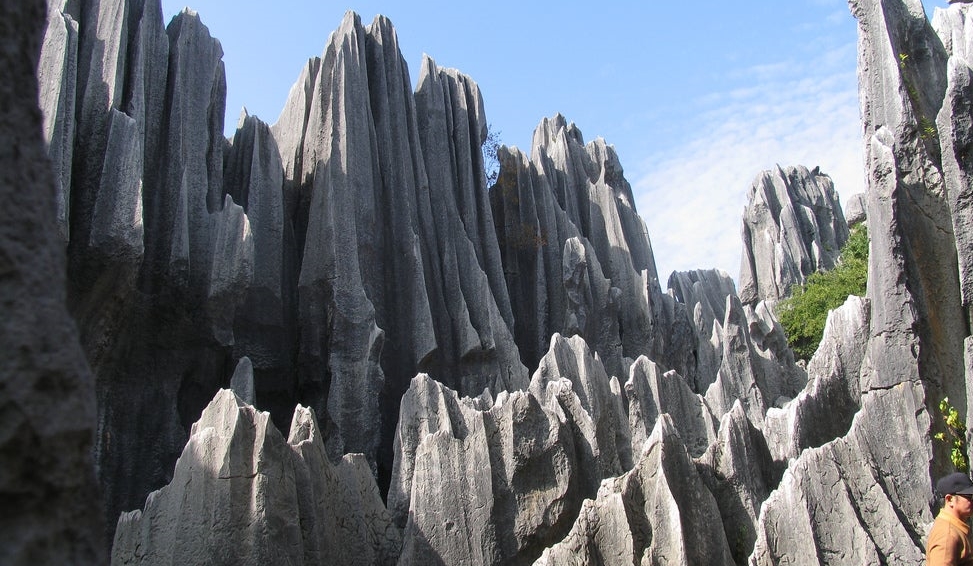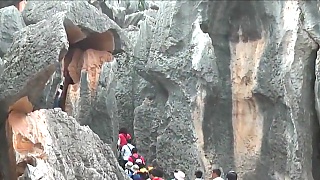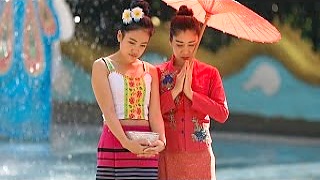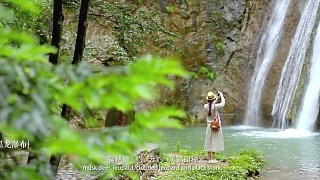Overview :
[640],shadow=true,start=125,stop=
Walk-through :
Music and dance :
[320],shadow=true,start=,stop=
Fly-over and night-time :
[320],shadow=true,start=,stop=
The Stone Forest is not far from the city of Kunming.
Kunming, the capital of China's Yunnan province, is known as the 'City of Eternal Spring' due to its mild climate year-round. It's a vibrant city with a rich cultural heritage, stunning natural scenery, and diverse ethnic minority communities. Here's a guide for tourists visiting Kunming:
Natural Attractions:
Stone Forest (Shilin): Located about 90 kilometers southeast of Kunming, the Stone Forest is a UNESCO World Heritage Site known for its surreal limestone formations resembling a forest of stone pillars. Visitors can explore the maze-like paths, visit local villages, and learn about the Yi ethnic minority culture.
Dianchi Lake: Kunming's largest lake offers scenic views, waterfront parks, and recreational activities such as boating and fishing. Nearby attractions include the Yunnan Nationalities Village, where visitors can learn about the diverse cultures of Yunnan's ethnic minority groups.
Jiaozi Snow Mountain: This scenic area northwest of Kunming features snow-capped peaks, alpine meadows, and hiking trails. Visitors can take a cable car ride to enjoy panoramic views of the surrounding landscape.
Cultural and Historical Sites:
Yuantong Temple: Dating back over 1,200 years, Yuantong Temple is one of the oldest and most important Buddhist temples in Kunming. It features traditional architecture, serene gardens, and ornate halls with Buddhist statues and artifacts.
Kunming Old Street (Guandu Ancient Town): Explore the historic streets and traditional architecture of Guandu Ancient Town, located on the outskirts of Kunming. Highlights include the Guandu Old Bridge, temples, and local markets.
Ethnic Minority Culture:
Yunnan Ethnic Village: This cultural theme park showcases the diverse traditions, customs, and architecture of Yunnan's ethnic minority groups, including the Yi, Bai, Dai, and Hani people. Visitors can watch cultural performances, shop for handicrafts, and sample ethnic cuisine.
Golden Temple (Jin Dian): Located on Mingfeng Hill, the Golden Temple is a Taoist temple complex known for its large copper pavilion covered in gold leaf. It offers panoramic views of Kunming and the surrounding countryside.
Modern Attractions:
Green Lake Park (Cuihu Park): This urban park in central Kunming is a popular recreational spot for locals and tourists alike. It features scenic walking paths, pavilions, gardens, and a variety of bird species.
Daguan Park: Known for its expansive lake and picturesque views of the Western Hills, Daguan Park is a tranquil retreat from the city's hustle and bustle. Visitors can stroll along the lakeside promenade, enjoy traditional tea houses, and admire the park's classical Chinese architecture.
Practical Tips:
Transportation: Kunming has a well-developed public transportation system, including buses and the Kunming Metro. Taxis and ride-hailing services are also widely available.
Weather: Kunming enjoys a mild climate year-round, but it can be cool and rainy in the winter months. It's advisable to check the weather forecast and pack accordingly.
Language: Mandarin Chinese is the official language, but English may not be widely spoken outside of tourist areas. It's helpful to learn a few basic phrases or carry a translation app, especially when interacting with locals from ethnic minority groups.
Kunming's blend of natural beauty, cultural diversity, and historical charm makes it a fascinating destination for tourists. Whether you're exploring ancient temples, admiring stunning landscapes, or immersing yourself in ethnic minority culture, Kunming offers a unique and memorable experience for visitors of all interests.

 The Stone Forest at ShiLin 石林, YunNan province
The Stone Forest at ShiLin 石林, YunNan province


















![No video in this post. At BB, we think this is something crucial to well-being and we`ll do our best to convey our experience ... The most important point is - don`t imagine that you can `fix` things - at the start, one needs 3 or 4 meetings to relax and know someone - but beyond that, if things are not going well, get out early; one cannot `fix` incompatibility, and certainly not a narcissist (they kind of know that they are wacko, but will never, ever admit it). `Love` shouldn`t require a lot of work; a bit maybe; but if one senses that it is all `one way`, or not going anywhere, quit. The relationship is very unlikely to get better; it almost certainly will get worse. Doomed. Save yourself years of wasted life. If you don`t, expect to become bitter and twisted yourself. At BB, we feel that health is THE foundation to all else, so we do cover health in this regard, although primarily a travel and culture site. Thousand page books are not our thing; we get straight to the point. If you want to delve deeper, consider this - why is a relationship so important to you ? Going beyond `animal instincts` is beyond many - they never really mature. If the immature instinct is made the `gold standard`, what can one expect ? If one cannot go beyond the animal brain, one is f****d [animal brain lingo]. The thing is, bad relationships that progress to having kids, can produce sad / bad kids (that may have to endure two decades of emotional abuse). And likely to repeat the cycle, and possibly go into politics, etc. - hence, it is very important to not be a part of this. Maybe, romantic `love` is simply the grand distraction meme that helps keep the elite in power. Relationships not going well – BB’s take – quit early](https://www.beijingbuzzz.com/choral3.jpg)




